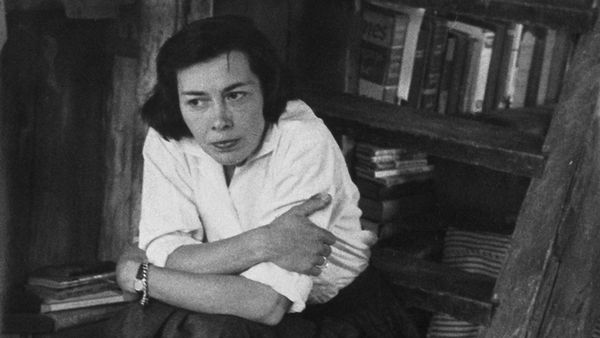 |
| The American Friend director Wim Wenders on Patricia Highsmith: “Amazing strong person.” Photo: courtesy of Swiss Literary Archives |
In honour of Patricia Highsmith and the US theatrical première of Eva Vitija’s intimate Loving Highsmith, Film Forum in New York has scheduled movies adapted from the novels of the acclaimed author to show simultaneously with the documentary.
 |
| Eva Vitija with Anne-Katrin Titze: “The character of Ripley shows much about Patricia Highsmith herself.” |
Highsmith On Screen includes Alfred Hitchcock’s Strangers On A Train (adaptation by Whitfield Cook, screenplay by Raymond Chandler and Czenzi Ormonde with Ben Hecht uncredited, starring Farley Granger and Robert Walker); René Clément’s Purple Noon (screenplay with Paul Gégauff, starring Alain Delon); Wim Wenders’s The American Friend (starring Dennis Hopper and Bruno Ganz); Anthony Minghella’s The Talented Mr. Ripley (with fabulous costumes by Ann Roth for Matt Damon, Jude Law, Gwyneth Paltrow, Cate Blanchett, Philip Seymour Hoffman), and Todd Haynes’s Carol (screenplay by Phyllis Nagy, adapted from The Price of Salt, starring Rooney Mara, Kyle Chandler, and Blanchett).
On-camera interviews with Tabea Blumenschein, Marijane Meaker, Monique Buffet, and Highsmith family members Judy Coates, Courtney Coates-Blackman, and Dan Coates are interwoven with readings from Highsmith’s writings by Gwendoline Christie and Maren Kroymann. Annina Butterworth is the narrator who guides us through the ups and downs of her private life.
After seeing Loving Highsmith I sent an email to Wim Wenders. He wrote back on Patricia Highsmith: “I did love her! Amazing strong person. - Wim”
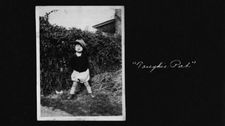 |
| Patricia Highsmith as a child in Fort Worth, Texas, 'Toughie Pat' Photo: Highsmith family archives |
From Zurich, Eva Vitija joined me on Zoom for an in-depth conversation on Loving Highsmith and Patricia Highsmith.
Anne-Katrin Titze: You are from Switzerland and of course Patricia Highsmith knows Switzerland very well. From Texas to the Tessin.
Eva Vitija: Exactly.
AKT: You start your film with a lovely quote about how “ideas come to me like birds.” Then you go into the probably most brutal and vicious scene from Alfred Hitchcock’s Strangers on a Train. About five minutes ago, looking at my notes I realized that it’s the Tunnel of Love. And love is the theme of your film! Tell me about the beginning and how you chose to start with this very strong clip!
EV: I was also really astonished that Hitchcock had chosen this Tunnel of Love as a motif and I found it perfectly fit the topic of our film. It’s the total focus of the film, the love stories of Patricia Highsmith. Since this is the underlying topic underneath all her literature, that is normally understood as this crime literature, although she doesn’t see it like that, I felt it’s the perfect beginning to have those two layers together in the very start.
 |
| Patricia Highsmith in 1942, at 21 Photo: Rolf Tietgens, courtesy of Keith de Lellis |
And then I think the quote has a bit about her poetic and sensitive side as well, which is an important part of this film. That she’s not, as you see in the Hitchcock clip, the usual brutal dark somber crime-writer lady that she is normally described as. What I discovered in her personal writings was somewhat different and why I wanted to make a film. I had something to contribute to this image that is new.
AKT: You also show how devastated she was. I want to begin with her childhood. I love the rodeo footage and “Toughie Pat” which is such a great image. You show us her beginnings in Texas and interview members of her family to whom you reveal new aspects as well. Tell me about those interviews in Texas!
EV: I went to the family, which was actually the first thing I did after having been in the archives reading her unpublished texts. Not all of them yet, but a little of them. I wasn’t quite sure where the rights are and I thought I just start with the family. She said several times that she was made, her character was very much made during the very first years. It’s never been a big focus in the biographies.
AKT: She says something like: My character was essentially made before the age of six.
 |
| Cate Blanchett in Todd Haynes’s Carol |
EV: I think she says it several times also in the diaries and I think it’s really true. Because her personality was formed in her very early years and somehow in a way she didn’t change much and in another way she changed hugely. It’s always difficult to say something about Patricia Highsmith because quite for sure the opposite will also be true.
Texas was the beginning and they were quite open to my request. I think they didn’t really know how famous she was around the world. For them it was their aunt, somebody who wrote. They knew her literature and the film adaptations but they didn’t know how famous she was. I think generally in the US she is not as famous as she is in other countries. They just let me go through all the stuff they had, boxes with material.
AKT: That’s great!
EV: Yes, it was pretty fantastic as a filmmaker. I discovered all those unpublished very beautiful photos of her youth and her childhood. One of them was this Toughie Pat, which I really adore. It says a lot about her character. She was quite critical about Texas after, but I think she has taken a lot of that culture with her. Somehow for me she was always a little bit the cowboy as well.
AKT: The tough little cowboy but also at some point, and I think you show that very well visually, she identified with the little calf.
 |
| Jude Law and Matt Damon in Anthony Minghella’s The Talented Mr. Ripley |
EV: Yes she is both of them, absolutely.
AKT: You show clips from definitely four of my favorite Highsmith films. There is Hitchcock’s Strangers on a Train, Ripley, the MInghella take from which you show the wonderful “May I” Bing Crosby scene with Matt Damon lip-synching and Jude Law coming in [costumes by the fantastic Ann Roth]. And also Carol and Wim Wenders’s The American Friend. It’s all about beauty and threat, mainly identity being threatened. Do you have a favourite among those films?
EV: I think my favourite is probably The Talented Mr. Ripley. When you edit an already made film in the editing room, you discover a lot about a film. Some films get a little flatter but this one in every little scene, every detail is so well done, I love that film. I also love the interpretation of Matt Damon in it.
AKT: I do too.
EV: Also there was this wonderful film with Alain Delon, Purple Noon?
AKT: Yes, I love Purple Noon.
EV: It wasn’t in the film because it was a bit of a question of money to get all the films. We had to choose a bit. I think it was important to choose The Talented Mr. Ripley because the subplot of homosexuality was there and in the adaptations before it just wasn’t.
 |
| Bruno Ganz with Dennis Hopper in Wim Wenders’ The American Friend, loosely based on Ripley’s Game |
The character of Ripley shows much about Patricia Highsmith herself. She had that question of guilt in her own life and I think for her it was like a utopia to write about somebody who doesn’t feel any kind of guilt, who is unscrupulous. And this dancing scene shows this really well. This guy has a moment of totally guilt-free existence.
AKT: And then he is caught by Dickie Greenleaf at that very moment!
EV: Yes, guilt is a topic in that scene.
AKT: Complete sense of freedom followed by somebody telling you “no.”
EV: Also stepping into someone else’s identity. Also I think the brutality in a lot of scenes in Patricia Highsmith was somehow always linked to love. If you look at her love scenes, for example in Carol, there’s always some blood somewhere in the love scene. Or bones or always some brutal scenes around it. I think this brutality has something to do with love. Of course the first murder in Ripley is done out of love, because he really wants to slip into the identity of the loved one who doesn’t give the love back.
AKT: Right! You have Tabea Blumenschein in your film. I was surprised, I never heard the name. I read up on her and found that she was working with Herbert Achternbusch and Ulrike Ottinger. The interviews with her are great and it seems that Highsmith was more infatuated with her than she was infatuated back.
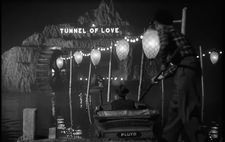 |
| Eva Vitija on Alfred Hitchcock’s Strangers On A Train: “I was also really astonished that Hitchcock had chosen this Tunnel of Love as a motif and I found it perfectly fit the topic of our film.” |
EV: Patricia Highsmith totally fell in love with that beautiful young woman who was a lot younger than herself. She was famous in the early Eighties in Germany for being this very changeable character, also gender wise changeable. She was also famous for partying of course. She went out as a man or as a very elegant female the next evening, this very free use of gender.
And I think Patricia Highsmith was very fascinated with her. For her Highsmith was another admirer and she had lots of admirers. At that time she was together with Ulrike Ottinger. They were a couple and doing those very interesting films together in the Seventies and Eighties.
AKT: There was a sentence I adored. Marijane Meaker talks about when she and Patricia Highsmith moved to the countryside. She says “The seven of us moved to the countryside,” which includes very specifically, Patricia’s one cat and her four cats. These are beautiful little nugget details.
EV: Thank you! It was nice, all those detailed memories that she had. You could imagine very well the two women with the moaning cats in the car for a long drive. She also said that they had their first little fight because Patricia wanted to stop for lunch and she thought it was not fair to the cats who were in the back of the car.
AKT: That’s beautiful! There is an archival interview with Patricia Highsmith with Nobel Prize winner Elfriede Jelinek.
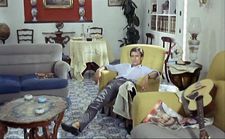 |
| Alain Delon in René Clément’s Purple Noon |
EV: There is an interview, yes, by the German television Rundfunk Berlin-Brandenburg. It’s not in the film. There might be a little piece of it but it’s not the interview itself. It’s actually a very great interview for literature lovers. But it’s unfortunately dubbed in German and there is no version without dubbing.
AKT: “The profound indignity being interviewed” is a Highsmith quote. Do you feel the indignity?
EV: No, I’m fine with being interviewed. I think with Patricia Highsmith it was more of an intrusion into her private life that she didn’t like. As you make a film about so many private things about somebody and especially somebody not too fond of telling too much about their life, you always ask yourself is it okay to ask all those questions and to put it in the spotlight.
It’s clear that she was aware that her diaries would once be published [they were published in the fall of 2021 to celebrate her centenary]. She once wrote it’s okay if it’s seen through the “looking glass of homosexuality,” that’s fine for her. She herself was conscious that this probably will be a topic if ever this was going to be published.
AKT: Thank you very much! I learned a lot more about Patricia Highsmith from your film. How’s the weather in Switzerland?
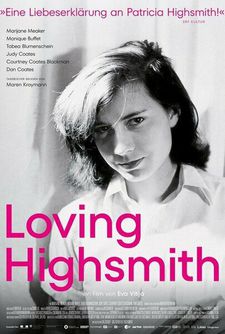 |
| Loving Highsmith poster |
EV: Very nice, actually warm. How is it in New York?
AKT: It’s very nice at the moment, not too hot. Bye!
EV: Thank you so much!
In-cinema post-screening Q&As with Eva Vitija will take place on Friday, September 2 at 8:00pm (moderated by Literary Hub Senior Film Writer Olivia Rutigliano) and Saturday, September 3 at 6:00pm (moderated by novelist Megan Abbott).
Film Forum Highsmith On Screen -
- Purple Noon on Friday, September 2 at 3:00pm and 8:00pm, Tuesday, September 6 at 8:00pm
- Stranger on a Train on Saturday, September 3 at 3:00pm and 8:00pm, Wednesday, September 7 at 8:00pm
- The American Friend on Sunday, September 4 at 3:00pm and 8:00pm
- The Talented Mr. Ripley on Monday, September 5 at 3:00pm and 8:00pm
- Carol on Thursday, September 8 at 3:00pm and 8:00pm





















